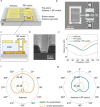HfO2 Memristor-Based Flexible Radio Frequency Switches
- PMID: 39704722
- PMCID: PMC11752509
- DOI: 10.1021/acsnano.4c11846
HfO2 Memristor-Based Flexible Radio Frequency Switches
Abstract
Flexible and wearable electronics are experiencing rapid growth due to the increasing demand for multifunctional, lightweight, and portable devices. However, the growing demands of interactive applications driven by the rise of AI reveal the inadequate connectivity of current connection technologies. In this work, we successfully leverage memristive technology to develop a flexible radio frequency (RF) switch, optimized for 6G-compatible communication systems and adaptable to flexible applications. The flexible RF switch demonstrates a low insertion loss (2 dB) and a cutoff frequency exceeding 840 GHz, and performance metrics are maintained after 106 switching cycles and 2500 mechanical bending cycles, showing excellent reliability and robustness. Furthermore, the RF switch is fully integrable with a photolithography-processable polyimide (PSPI) substrate, enabling efficient 2.5D integration with other RF components, such as RF antennas and interconnects. This technology holds significant promise to advance 6G communications in flexible electronics, offering a scalable solution for high-speed data transmission in next-generation wearable devices.
Keywords: 2.5D integration; 6G communication; RF switch; flexible electronics; memristor.
Conflict of interest statement
The authors declare no competing financial interest.
Figures





References
-
- Lien D.-H.; Wang H.-P.; Chen S.-B.; Chi Y.-C.; Wu C.-L.; Lin G.-R.; Liao Y.-C.; He J.-H. 360° omnidirectional, printable and transparent photodetectors for flexible optoelectronics. npj Flexible Electron. 2018, 2 (1), 19.10.1038/s41528-018-0032-2. - DOI
-
- Chih H.-Y.; Ahmed T.; Chiu A. P.; Liu Y.-T.; Kuo H.-F.; Yang A. C.; Lien D.-H. Multitask Learning for Automated Sleep Staging and Wearable Technology Integration. Adv. Intell. Syst. 2024, 6 (1), 230027010.1002/aisy.202300270. - DOI
-
- Zang Y.; Zhang F.; Di C.-A.; Zhu D. Advances of flexible pressure sensors toward artificial intelligence and health care applications. Mater. Horiz. 2015, 2 (2), 140–156. 10.1039/C4MH00147H. - DOI
-
- Li Y.; Zheng L.; Wang X. Flexible and wearable healthcare sensors for visual reality health-monitoring. Virtual Reality & Intelligent Hardware 2019, 1 (4), 411–427. 10.1016/j.vrih.2019.08.001. - DOI
LinkOut - more resources
Full Text Sources
Miscellaneous

